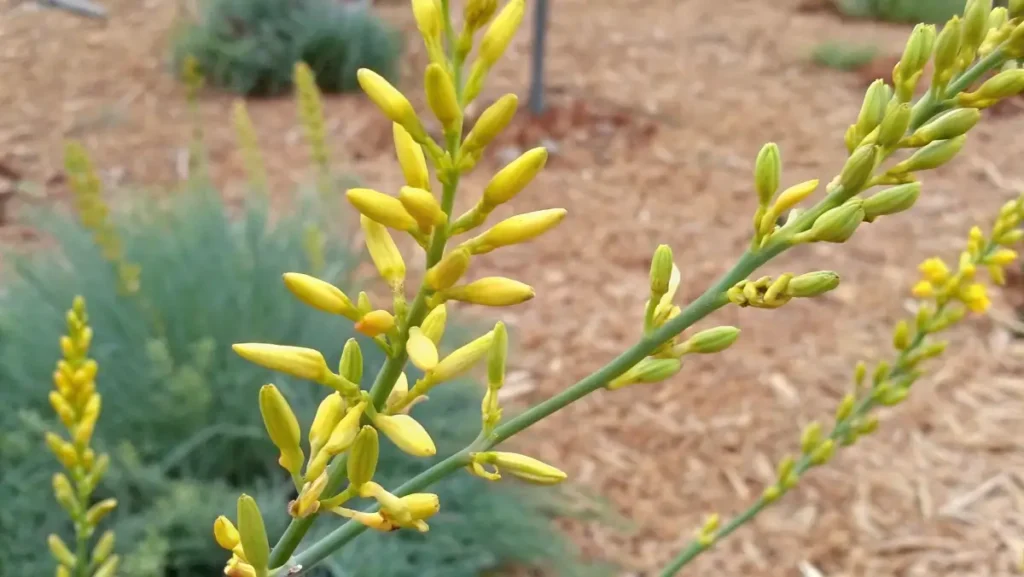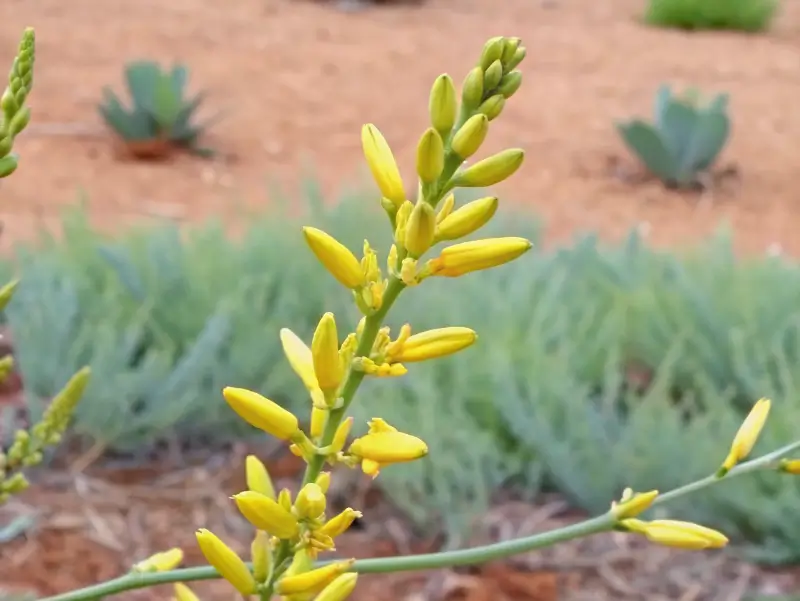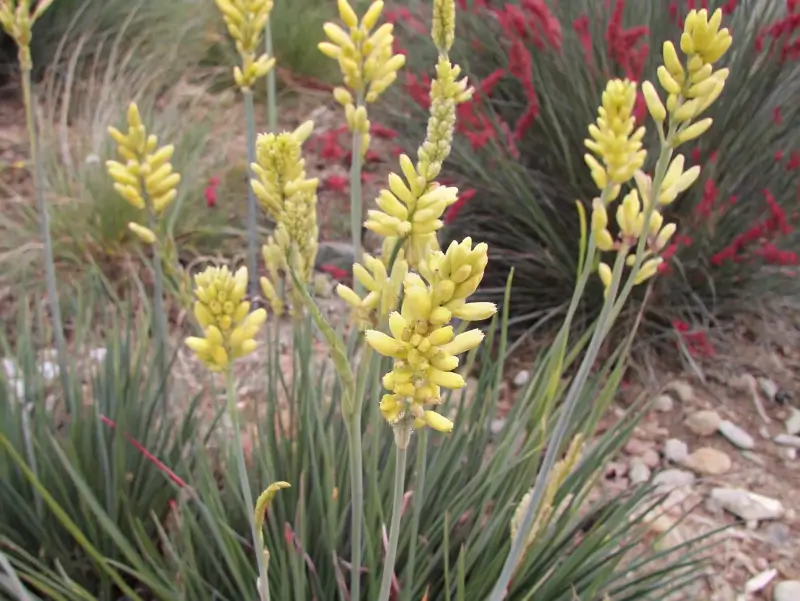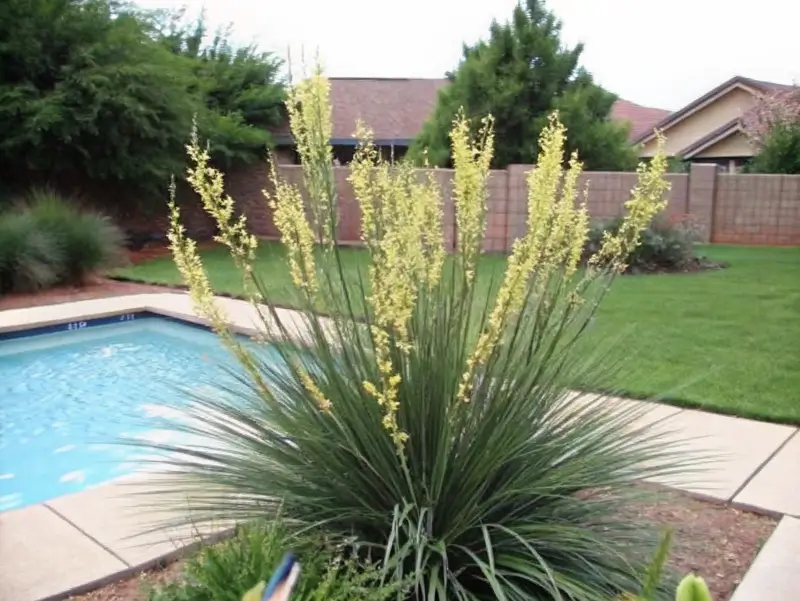
Everyone deserves a cheerful, fuss-free plant that thrives with minimal care. The yellow yucca plant is a sun-loving, desert-style succulent perfect for bright patios or windowsills. This blog covers its standout features, planting hacks, watering tips, and solutions for yucca plant leaves turning yellow. Expect straightforward advice plus personal insight. Having tested it myself in scorching conditions, I’ve seen firsthand how resilient it can be. If you’re craving a golden, low-effort accent, buckle up and discover your new favorite succulent.
Table of Contents
Introduction to the Yellow Yucca Plant
Overview: Defining the Yellow Yucca Plant
I first came across the yellow yucca plant at a local nursery, and it immediately caught my eye. This star, also called hesperaloe parviflora yellow or yucca yellow sometimes, offers that perfect desert flair. Its upright leaves form a rosette, showing off various shades from subtle lime to gleaming gold.
- Resilience is key: the yellow yucca plant barely complains about drought.
- Plenty of gardeners adore it for minimal watering needs.
- It pairs nicely with other succulents or a bold red and yellow plant arrangement.
Funny enough, my biggest draw was how the yellow yucca plant seems to say, “Go ahead, forget a watering day—I’ll still look good.” If your schedule is hectic, it’s a solid option.
Origins and Background of This Desert Beauty
Because the yellow yucca plant hails from dry regions, it boasts a talent for saving water in its thick leaves:
- Ideal for places that see limited rainfall.
- It can shrug off blistering sun and high temps with style.
- Adaptable in rocky or sandy soils, making it a top contender for xeriscape design.
To me, the yellow yucca plant represents an easygoing approach to greenery. Plant it, water here and there, watch the bright leaves do their thing.
Understanding Its Key Characteristics
Shape, Size, and Foliage Features
Each yellow yucca plant leaf shoots up like a slim, sword-like blade. Once the plant is comfy:
- It can span around two feet in height.
- Leaves develop a striking gold color, especially under direct sun.
- The rosette shape gives a tidy yet dramatic silhouette.
I love how my yellow yucca plant pops against dark mulch. If you’ve wondered what colors is the plant yucca, this one typically leans golden, though some individuals are more limey. Either way, it’s far from boring.
Bloom Cycle and Flower Appearance
After some maturity, you may see tall stalks shooting out from the center:
- The blooms can create a red and yellow plant combo, especially if there’s cross-pollination.
- Flowers rise above the leaves, offering a colorful vertical element.
- Hummingbirds often buzz around these tubular blooms.
Whenever my yellow yucca plant decides to flower, I can’t help but smile at the extra flash of color. Even if it doesn’t bloom every year, the bright leaves hold their own as a garden accent. Personally, I find the spiky rosette alone worthy of any sunny space.
Ideal Growing Conditions

Soil and Climate Preferences
Like many succulents, the yellow yucca plant needs soil that drains fast.
- If you’re stuck with dense or clay-based earth, mixing in coarse sand or perlite helps.
- A cactus blend is often perfect if you’re planting in containers.
- Standing water can trigger root rot quickly.
The yellow yucca plant also handles warmth like a champ. Mine endures peak summer heat without blinking. Just remember: if the roots remain soggy for too long, you might see yucca plant leaves turning yellow from stress.
Tip: For more ideas on water-smart gardening, check out the official EPA WaterSense Guidelines. They cover helpful ways to conserve moisture while still giving your succulent the hydration it needs.
Regarding Climate
- Mild frosts can be tolerated if brief.
- Extended freezing often damages leaves.
- Checking your zone ensures you protect the yellow yucca plant adequately.
Sunlight Exposure vs. Partial Shade
Strong, direct sunlight is the best scenario for the yellow yucca plant:
- Aim for around six hours a day.
- In searing climates, a bit of afternoon shade can help.
- Overly shaded conditions can dull that lovely gold.
I love combining a yellow yucca plant with a pinky plant for fun color contrasts or a silver buttonwood plant for a calm silvery accent. For me, it’s about letting these plants thrive where the sun hits them best. If your yellow leaves on yucca plant look weak, move it to a brighter spot and let the ground dry before any more watering.
Best Practices for Planting and Propagation
Seed Propagation vs. Offshoot Division
Growing the yellow yucca plant can be done in two main ways:
- Seeds
- Harvest seeds from dried flower pods.
- Sow in a well-draining, sandy blend.
- Stay patient—it can take a while for sprouts.
- Offshoots
- Mature plants may produce small plastic-like pups at the base.
- Carefully remove them, ensuring some roots remain intact.
- Plant or pot them in sunnier spaces.
I prefer dividing pups because the results are much faster. Whenever my older yellow yucca plant sends out new rosettes, I relocate them to other parts of the yard or gift them to friends.
Potting and Transplanting Tips
If containers are your jam:
- Get a pot with drainage holes.
- Use a special cactus/succulent soil blend.
- Avoid burying the crown too deep.
Out in the garden, gently loosen the roots when transplanting. Spring or fall usually offers nice, moderate weather for settling in. A bit of light watering in the early weeks helps roots adapt, but don’t drown them.
Watering, Fertilizing, and General Care

Effective Irrigation Strategies
I’ve had success using a “deep and infrequent” model:
- Water thoroughly so moisture reaches the root zone.
- Wait for the top inch or two to fully dry before watering again.
- Frequency will depend on your climate—maybe once a week in summer, less in winter.
If in doubt, err on the dry side; too much water leads to major trouble for any yellow yucca plant. Checking soil dryness is as easy as poking a finger into the top layer. My main rule: when in doubt, wait a bit longer before watering again.
Choosing the Right Fertilizer
Although your yellow yucca plant can survive with minimal feeding, a gentle boost helps it flourish:
- Use a balanced succulent fertilizer at half strength.
- Feed in spring or early summer to align with its growth spurt.
- Overdoing it can cause leaf burn or floppiness.
General Maintenance
- Prune away fully dry or brown leaves at the base.
- Look out for mealybugs or spider mites.
- Rotate potted specimens if they bend toward a single light direction.
In my yard, the yellow yucca plant typically needs just a few check-ins each season. The rest of the time, it’s content soaking up sunshine and sipping water occasionally.
Common Problems and Troubleshooting
Dealing with Yellowing Leaves and Pests
A bit of leaf yellowing is totally normal—especially the older leaves that the plant discards. If the entire yellow yucca plant loses color or becomes mushy, it might be:
- Overwatering: Let the soil dry well.
- Pests: Mealybugs leave cottony spots, spider mites spin faint webs.
- Not enough sunlight? Relocate the plant where it can receive more direct light.
To chase off bugs, wipe leaves with a cloth dipped in mild soapy water. For stubborn issues, you might need an insecticidal soap. Keeping the area well-ventilated and dryness in check can help prevent infestations.
Reviving a Struggling “Yellow Yucca”
I’ve rescued a limp plant by focusing on water, light, and root health:
- Adjust watering. Cease if the soil is drenched, or step up slightly if bone-dry.
- Sunlight boost. Shift the plant to a brighter spot gradually to avoid shock.
- Repot if root rot. Snip off squishy roots and replant in clean, gritty soil.
- Pause on heavy feeding until leaves regain strength.
Once corrected, many yellow yucca plant problems sort out over a couple of weeks. You’ll see sturdier, happier leaves if you’ve fixed the root cause—be it too much water or too little sunlight. Official USDA resources on arid-climate gardening can also provide general insight into caring for drought-tolerant species.
Landscaping with This Radiant Succulent

Design Ideas for Outdoor Spaces
One yellow yucca plant can rejuvenate an empty corner with its golden flair. Some gardeners form a row of them along a pathway, blending the bold rosettes with decorative stones or gravel. If you’re up for a vibrant mix:
- Blend with cacti for that dreamy desert look.
- Insert a red and yellow plant near it to really pop the warm hues.
- Scatter ornamental grasses around for texture contrast.
Container Gardening for a Dazzling Display
Have limited yard space? The yellow yucca plant adapts nicely to large pots:
- Make sure the pot has solid drainage.
- Position it where the sun hits most of the day.
- Rotate occasionally if you see leaning leaves.
Whether in a patio pot or a larger xeriscape, these plants demand little but give a lot, projecting confidence and color.
FAQs on the Yellow Yucca Plant
How do you take care of a yellow yucca plant?
Keep it simple:
- Place in bright or direct sun.
- Give the soil a thorough soak, then allow it to dry out fully before the next watering.
- Snip old leaves as they fade.
- Lightly fertilize once or twice yearly.
Should I remove yellow yucca leaves?
Yes, if they’re truly done:
- Older foliage shrinks up and can be gently tugged off.
- Leave partially green leaves alone until they finish drying.
Does yucca need sun or shade?
Mostly sun. Too much shade promotes weak, sad-looking growth. In extreme heat, a bit of afternoon relief might help, but generally, a yellow yucca plant loves sunshine.
How do you revive a yellow yucca plant?
Balance is key:
- Dry out soggy soil or water if it’s bone dry.
- Shift it to a brighter spot if needed.
- Trim off rotten roots and repot in cactus mix.
- Let it recover before any heavy feeding.
Conclusion
Final Thoughts on This Bright Survivor
The yellow yucca plant remains one of my top picks for a sun-drenched, low-hassle garden companion. It shrugs off tough conditions, stays bold and beautiful with minimal care, and can even bloom with showy spikes for added flair. If you’re busy or have scorching summers, this plant is a practical choice for your yard, porch, or balcony.
- It can handle blazing sun with minimal watering.
- The rich gold color sets it apart from standard greenery.
- Occasional pruning and rare fertilizing keep it in top form.
I still remember bringing my first yellow yucca plant home and realizing how tough it was compared to other high-maintenance options. That’s why I keep recommending it to anyone craving an easy but visually striking succulent. For me, the allure is clear: a bright, energetic pop that doesn’t require babysitting—just sunshine and a bit of occasional watering.
Essential Takeaways
- Opt for direct light and quick-draining soil.
- Avoid constant moisture; let dryness happen.
- Watch for minor pests and prune old leaves.
- Enjoy the reliable, desert-inspired charm of this golden beauty!
